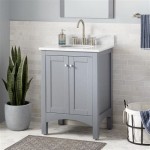Understanding Bathroom Sink Unit Dimensions: A Comprehensive Guide
Selecting the appropriate bathroom sink unit requires careful consideration of dimensions to ensure functionality, aesthetics, and comfortable use within the available space. Bathroom sink units, encompassing the sink and the supporting cabinet or pedestal, come in a wide array of sizes and configurations. Understanding these dimensions is crucial for successful bathroom renovations, new construction, and simple replacements.
This article provides a comprehensive overview of bathroom sink unit dimensions, covering standard sizes, factors influencing size selection, and specific considerations for various bathroom types. The focus remains on providing objective information to assist in informed decision-making regarding bathroom sink unit selection.
Standard Bathroom Sink Unit Dimensions
While bathroom sink unit dimensions vary based on style and manufacturer, some standard measurements serve as a general guideline. These standards are often dictated by building codes and ergonomic considerations. Deviations from these standards are common but understanding the baseline provides a valuable starting point.
Height: The standard height for a bathroom sink unit, measured from the floor to the top of the sink, typically ranges from 30 to 36 inches (76 to 91 cm). A common height is 32 inches (81 cm), which is generally considered comfortable for most adults. However, taller individuals might prefer a height closer to 36 inches for improved ergonomics. ADA-compliant sinks, designed for accessibility, are typically installed at a height of around 34 inches (86 cm).
Width: Bathroom sink unit width is significantly more variable than height and depends heavily on the style and number of sinks incorporated. Single-sink vanities typically range from 24 to 48 inches (61 to 122 cm) in width. Smaller bathrooms often utilize vanities with a width of 24 to 30 inches (61 to 76 cm), while larger bathrooms can accommodate vanities 36 inches (91 cm) or wider. Double-sink vanities can extend to 60, 72, or even 84 inches (152, 183, or 213 cm) depending on the design and sink spacing.
Depth: The depth of a bathroom sink unit, measured from the front edge to the back wall, usually falls within the range of 17 to 24 inches (43 to 61 cm). A depth of 21 inches (53 cm) is a common standard. Deeper vanities provide more counter space but may encroach on floor space, which is particularly important in smaller bathrooms. Narrower vanities, with a depth of 17 to 19 inches (43 to 48 cm), are often used in powder rooms or bathrooms with limited space.
It is important to note that these are just standard ranges. Manufacturers produce sinks and vanities that fall outside these dimensions. Always check the specific product specifications before making a purchase.
Factors Influencing Bathroom Sink Unit Size Selection
Choosing the right bathroom sink unit dimensions involves considering several key factors. These factors relate to bathroom size, user needs, style preferences, and accessibility requirements. A careful evaluation of these elements ensures the selected sink unit is both functional and aesthetically pleasing.
Bathroom Size and Layout: The dimensions of the bathroom are the most critical factor in determining the appropriate size of the sink unit. Smaller bathrooms require smaller vanities to avoid overcrowding. A vanity that is too large can restrict movement and make the space feel cramped. It is recommended to measure the available space carefully and consider the placement of other fixtures, such as the toilet and shower, to ensure adequate clearance. A general rule of thumb is to allow at least 30 inches (76 cm) of clear space in front of the sink.
User Needs and Storage Requirements: The number of users and their storage needs significantly influence the size of the sink unit. Bathrooms used by multiple people, such as family bathrooms, often benefit from larger vanities with ample counter space and storage. Double-sink vanities are particularly useful in these situations, providing separate washing areas for each user. Consider the amount of storage space required for toiletries, towels, and other bathroom essentials. Vanities with drawers, shelves, and cabinets can help keep the bathroom organized and clutter-free.
Style and Aesthetics: The style of the bathroom sink unit should complement the overall aesthetic of the bathroom. Vanities are available in a wide range of styles, from traditional to modern, and in various materials, such as wood, laminate, and metal. The size and shape of the sink itself also contribute to the overall aesthetic. Vessel sinks, for example, sit on top of the counter and can add a unique visual element. Undermount sinks, on the other hand, are installed beneath the counter and create a clean, seamless look. The color and finish of the vanity should also coordinate with other bathroom fixtures and finishes.
Accessibility Considerations: For individuals with mobility impairments, accessibility is a crucial factor in sink unit selection. ADA-compliant sinks are designed to be easily accessible to people using wheelchairs or other mobility devices. These sinks typically have a height of around 34 inches (86 cm) and feature open space underneath the vanity to allow for knee clearance. Faucets should be easy to operate with one hand and should not require excessive reaching. Consider the placement of grab bars and other accessibility aids to ensure the bathroom is safe and functional for all users.
Specific Considerations for Different Bathroom Types
Bathroom sink unit dimensions are also influenced by the type of bathroom. Powder rooms, master bathrooms, and children's bathrooms each have unique requirements that should be considered when selecting a sink unit.
Powder Rooms: Powder rooms are typically small, guest bathrooms that contain only a toilet and a sink. Space is often limited, so compact sink units are ideal. Wall-mounted sinks or small pedestal sinks are popular choices for powder rooms, as they take up minimal floor space. Corner sinks are another space-saving option. Vanity widths of 18 to 24 inches (46 to 61 cm) are generally sufficient for powder rooms. Depth is also a key factor; shallow depths of around 17 inches (43 cm) can help maximize the available space.
Master Bathrooms: Master bathrooms are typically larger than other bathrooms in the home and are often shared by multiple people. Larger sink units, including double-sink vanities, are common in master bathrooms. These vanities provide ample counter space and storage, making them ideal for households with multiple users. Vanity widths of 60 inches (152 cm) or more are often used in master bathrooms. Consider incorporating features such as built-in storage, makeup areas, and comfortable seating.
Children's Bathrooms: Bathrooms designed for children require special considerations for height and safety. Sinks should be installed at a height that is comfortable for children to reach, typically around 28 to 30 inches (71 to 76 cm). Adjustable-height vanities are a good option, as they can be raised as children grow. Rounded edges and durable materials are also important safety features. Consider incorporating colorful and fun design elements to make the bathroom more appealing to children.
Small Bathrooms: Maximizing space is crucial in small bathrooms. Wall-mounted sinks, corner sinks, and pedestal sinks are excellent choices for saving floor space. Floating vanities, which are mounted to the wall without legs, create an open and airy feel. Opt for a vanity with minimal depth to avoid encroaching on the walking area. Consider using a mirror above the sink to create the illusion of more space. Light colors and good lighting can also help make a small bathroom feel larger and brighter.
Large Bathrooms: In large bathrooms, there is greater flexibility in terms of sink unit size and configuration. Consider incorporating multiple sinks, a separate vanity area, or even a freestanding soaking tub. Larger vanities with ample storage and counter space can be used to create a luxurious and functional space. Consider the overall layout of the bathroom and ensure that there is adequate space for movement and other activities. Incorporating natural light and ventilation can also enhance the overall feel of the bathroom.
In conclusion, selecting the appropriate bathroom sink unit dimensions requires careful consideration of various factors, including bathroom size, user needs, style preferences, and accessibility requirements. Understanding standard dimensions and the specific considerations for different bathroom types is crucial for creating a functional, aesthetically pleasing, and comfortable bathroom space. Before making any decisions, thoroughly assess the available space, evaluate storage needs, and consider the overall design aesthetic to ensure the selected sink unit is the perfect fit for the bathroom.

Plan Your Bathroom By The Most Suitable Dimensions Guide Engineering Discoveries Vessel Sink Vanity Floor Plans Washbasin Design

Tidoin 30 In W X 18 D 34 5 H Freestanding Bath Vanity Gray With White Single Sink And Resin Top Vst Ydsv 2aaa The Home Depot

Dhp Jamison 24 Industrial Bathroom Vanity With Oval Ceramic Sink Walnut Com

What Is The Standard Height Of A Bathroom Vanity Sizes Vessel Sink Cabinets

Plan Your Bathroom By The Most Suitable Dimensions Guide Engineering Discoveries Vessel Sink Vanity Sizes

Bathroom Vanities Buy Vanity Furniture Cabinets Rgm Distribution

Oak Bathroom Vanity Cabinet Double Twin Sinks Bowl Basins

Bathroom Vanities Buy Vanity Furniture Cabinets Rgm Distribution

Pin By Tania Rejalaga On Bathroom Ideas Vanity Sizes Dimensions Modern

ᐅ Woodbridge Venice 48 X21 X33 Solid Wood Bath Vanities Side Cabinet In Grey And Brushed Nickel Trim Carrara Marble Vanity Top With 3 Pre Drilled Holes For 4 Inches Centerset Faucet
Related Posts







